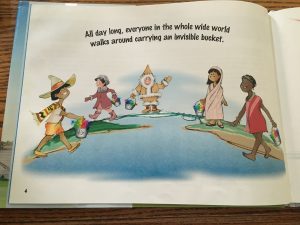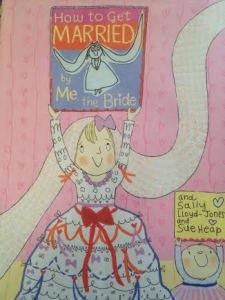
Author: Sally Lloyd-Jones
Illustrator: Sue Heap
Publishing Information: Schwartz & Wade Books, 2009
Number of Pages: 32
Tags: Fiction, Family, Picture Book, K-1
Genre: Realistic Fiction

Analysis:
This story serves as a step-by-step guide for how to find someone you’d like to marry, and how to, then, plan out a wedding. The story is told from the perspective of the “bride” and the strategies she uses for planning out her marriage.
I must admire the fact that the book is very inclusive, as the bride states a very diverse range of people you can marry, and brushes on the topic of polygamy as well when she says, “Usually, you’re not allowed to marry lots of people at once. Except sometimes you are” (Lloyd Jones, 8). As a result, I found that this would serve as a window to teach children to be very open-minded in terms of who another person chooses to marry, and the different types of families that result from those marriages. Also, it becomes both a mirror and a door, as they assess their own preferences in marriage and can practice both their own preferences and a tolerance for the preferences of others. As a result, I think that this simple how-to book can be a fun and more lighthearted way to teach children about an event that happens all the time.
Although the book is meant to be a silly and fun way to approach the topic, I did find bits of the story to be a bit problematic. The bride provides different lists of things you should not do in front of the person you like, or they won’t want to marry you. This could send a negative message to children that tells them that they must act a particular way to impress someone, rather than being themselves. Also, she creates a list of people you should not marry, which backpedals on the inclusiveness of the story, and teaches children that some people are less deserving of marriage/love than others. As a result, I think it sends the wrong message in some aspects, and I’m not sure I would want to read this to children in my classroom.
As a whole, I found this book to be a fun way for children to learn about the topic of marriage in terms they could understand. While I did have some critiques in some areas of the storyline, I was not completely turned off by the book and still found parts that I believe children can really benefit from.

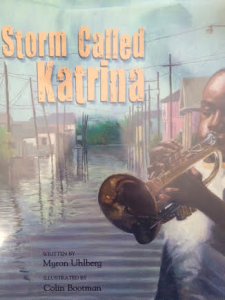
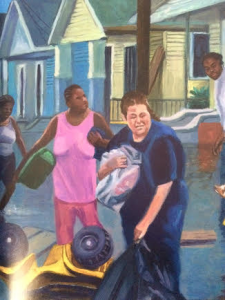
 Pinduli is the story of a beautiful hyena that wanders away from her mother into the East African wild. While Pinduli is wandering she runs into dogs, a lion and a zebra who all judged Pinduli’s looks. Pinduli becomes very self conscience and starts to change her looks to fit in, she gets to the point where she covers herself in dust making her look like a ghost. All the animals that once teased her were now afraid of her and begged her to forgive them for being mean since the believed she was a ghost. Pinduli told them they must find out why they were teasing others and give the one you teased food to be forgiven. Pinduli’s mother found her and reminded her of her inner and outer beauty
Pinduli is the story of a beautiful hyena that wanders away from her mother into the East African wild. While Pinduli is wandering she runs into dogs, a lion and a zebra who all judged Pinduli’s looks. Pinduli becomes very self conscience and starts to change her looks to fit in, she gets to the point where she covers herself in dust making her look like a ghost. All the animals that once teased her were now afraid of her and begged her to forgive them for being mean since the believed she was a ghost. Pinduli told them they must find out why they were teasing others and give the one you teased food to be forgiven. Pinduli’s mother found her and reminded her of her inner and outer beauty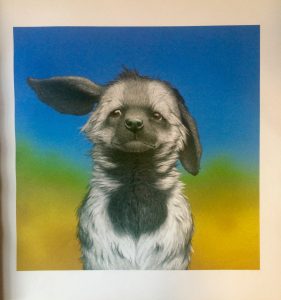

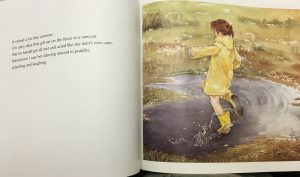 between both girls. As they continue to talk, the girls move closer together. In the story, the fence is a physical barrier between the interaction of the African American and the White populations. It also symbolically represents the barriers that people, especially African Americans, face in their lives. This title, The Other Side, also refers to another aspect of the story. This story features a main character that questions why racism and prejudice are ruling people’s lives. In this case, the character is the person on the other side of the powerful race during this time. This powerful theme carries into other aspects of life. Readers will benefit from the tolerance displayed in the story.
between both girls. As they continue to talk, the girls move closer together. In the story, the fence is a physical barrier between the interaction of the African American and the White populations. It also symbolically represents the barriers that people, especially African Americans, face in their lives. This title, The Other Side, also refers to another aspect of the story. This story features a main character that questions why racism and prejudice are ruling people’s lives. In this case, the character is the person on the other side of the powerful race during this time. This powerful theme carries into other aspects of life. Readers will benefit from the tolerance displayed in the story.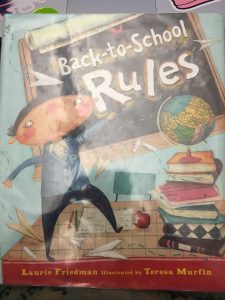 Title: Back-to-School Rules
Title: Back-to-School Rules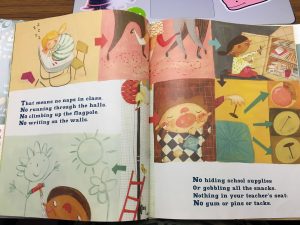 depicting the behaviors that Percy claims you should not do . Percy’s rules are often a different color in the text. The illustrator uses different techniques to display the information. For example, on one page, she uses arrows to display the order of which it appears in the text. On the next page, she uses a thought cloud to display the rules. The illustrator also uses a chalkboard to display the rules of Percy. Structurally, the text has a slight rhyming scheme. However, it is sometimes forced, making it difficult to hear the rhyming.
depicting the behaviors that Percy claims you should not do . Percy’s rules are often a different color in the text. The illustrator uses different techniques to display the information. For example, on one page, she uses arrows to display the order of which it appears in the text. On the next page, she uses a thought cloud to display the rules. The illustrator also uses a chalkboard to display the rules of Percy. Structurally, the text has a slight rhyming scheme. However, it is sometimes forced, making it difficult to hear the rhyming.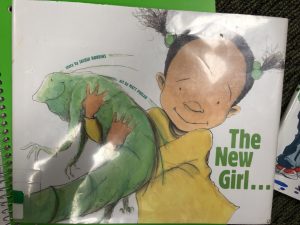
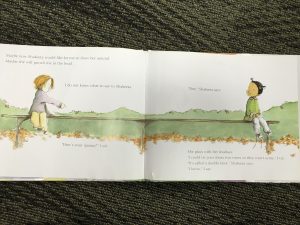

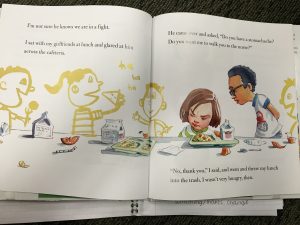 Perceptually, the images are very bright and enticing for the children. The use of faded watercolor pictures, such as in the picture below, allows the focus to remain on the narrator and James. The use of large text in certain areas allows the reader to recognize which points should be emphasized while reading the story aloud. Some of the illustrations resemble the ones that children would draw, making it very relatable for the readers. The layout of the text in relation to the pictures also allows the readers to follow the sequence very well, especially when the author is describing how each classmate heard the rumor about the narrator. Ideologically, this book shows the dangers of gossip and rumors and the effects they have on friendships. The misunderstanding during the “game of telephone” leads to the narrator’s feelings getting hurt by her best friend. Children who read this book are able to see the damage done by gossip and rumors. The ending of the book allows readers to see some things can be misunderstood and taken out of proportion. It also emphasizes the idea of friendship and its importance. The two sided story, the narrator and James’ actions, also show the different emotions when two friends are fighting. This book also gives an example of how children can solve problems with their friends. However, the way in which the narrator reacts is not recommended for children.
Perceptually, the images are very bright and enticing for the children. The use of faded watercolor pictures, such as in the picture below, allows the focus to remain on the narrator and James. The use of large text in certain areas allows the reader to recognize which points should be emphasized while reading the story aloud. Some of the illustrations resemble the ones that children would draw, making it very relatable for the readers. The layout of the text in relation to the pictures also allows the readers to follow the sequence very well, especially when the author is describing how each classmate heard the rumor about the narrator. Ideologically, this book shows the dangers of gossip and rumors and the effects they have on friendships. The misunderstanding during the “game of telephone” leads to the narrator’s feelings getting hurt by her best friend. Children who read this book are able to see the damage done by gossip and rumors. The ending of the book allows readers to see some things can be misunderstood and taken out of proportion. It also emphasizes the idea of friendship and its importance. The two sided story, the narrator and James’ actions, also show the different emotions when two friends are fighting. This book also gives an example of how children can solve problems with their friends. However, the way in which the narrator reacts is not recommended for children.![IMG_9614 [405971]](https://blogs.iwu.edu/lrbmt2016/files/2016/05/IMG_9614-405971-300x220.jpg)
![IMG_9615 [405972]](https://blogs.iwu.edu/lrbmt2016/files/2016/05/IMG_9615-405972-300x175.jpg)
![IMG_9622 [405979]](https://blogs.iwu.edu/lrbmt2016/files/2016/05/IMG_9622-405979-222x300.jpg) Author/Illustrator: Oliver Jeffers
Author/Illustrator: Oliver Jeffers![IMG_9623 [405980]](https://blogs.iwu.edu/lrbmt2016/files/2016/05/IMG_9623-405980-169x300.jpg)

